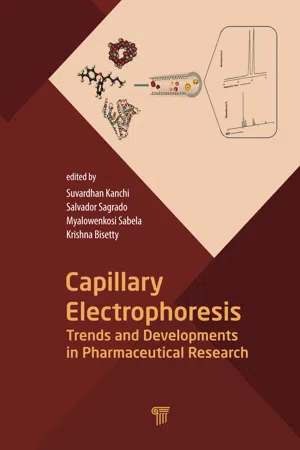![]()
Contents
Preface
1. Capillary Electrophoresis: A Versatile Technique in Pharmaceutical Analysis
Imran Ali, Zeid A. Alothman, Abdulrahman Alwarthan, and Hassan Y. Aboul-Enein
1.1 Introduction
1.2 Theory of Capillary Electrophoresis
1.3 Types of Capillary Electrophoresis
1.4 Instrumentation
1.4.1 Sample Introduction
1.4.2 Capillary Electrophoresis Capillary
1.4.3 Power Supply
1.4.4 Background Electrolyte
1.4.5 Detection
1.4.5.1 UV/Vis absorbance detectors
1.4.5.2 Conductivity detectors
1.4.5.3 Amperometric detectors
1.4.5.4 Thermooptical absorbance detectors
1.4.5.5 Fluorescence detectors
1.4.5.6 Atomic absorption spectroscopy detectors
1.4.5.7 Inductively coupled plasma detectors
1.4.5.8 Mass detectors
1.4.5.9 Miscellaneous detectors
1.4.5.10 Indirect detection
1.5 Data Integration
1.6 Sample Preparation
1.7 Method Development and Optimization
1.8 Validation of Methods
1.9 Applications
1.10 Conclusion
2. Recent Applications of Chiral Capillary Electrophoresis in Pharmaceutical Analysis
José María Saz and María Luisa Marina
2.1 Introduction
2.2 Chiral Selectors Added to BGE for Enantioseparation of Chiral Drugs by CCE
2.2.1 Cyclodextrins
2.2.2 Macrocyclic Antibiotics
2.2.3 Polysaccharides
2.2.4 Other Chiral Selectors
2.3 Applications of CCE in Pharmaceutical Analysis
2.3.1 Analysis of Pharmaceutical Formulations
2.3.2 Analysis of Illicit Drugs
2.3.3 Analysis of Biological Samples
3. A Mini-Review on Enantiomeric Separation of Ofloxacin using Capillary Electrophoresis: Pharmaceutical Applications
Suvardhan Kanchi, Myalowenkosi Sabela, Deepali Sharma, and Krishna Bisetty
3.1 Introduction
3.2 Role of CE in Pharmaceutical Analysis
3.3 Challenges Involved in the Enantiomeric Separation of Ofloxacin
3.4 Developments in Enanatiomeric Separation of Ofloxacin
3.4.1 Recent Developments in Enantiomeric Separation of Ofloxacin
3.5 Applications of Nanotechnology in Enantiomeric Separation of Ofloxacin
3.6 Role of Computational Techniques in Enantiomeric Separation of Ofloxacin
3.6.1 Molecular Modeling
3.6.2 Molecular Dynamic Simulations
3.7 Conclusion
4. Nano-Stationary Phases for Capillary Electrophoresis Techniques
Chaudhery Mustansar Hussain and Sagar Roy
4.1 Introduction
4.2 Different Types of Nanoparticles/Nanomaterials
4.3 Synthetic Strategies for Immobilization for Nano-Stationary Phases
4.4 Evaluation of Nano-Stationary Phases
4.5 Conclusion
5. Capillary Electrophoresis Coupled to Mass Spectrometry for Enantiomeric Drugs Analysis
Vítězslav Maier, Martin Švidrnoch, and Jan Petr
5.1 Enantioseparation of Pharmaceutical Products
5.2 Basic Concepts of Enantioseparation by Capillary Electrophoresis
5.3 Capillary Electrophoresis with Mass Spectrometry
5.3.1 Electrospray Ionization in Hyphenation of CE with MS
5.4 Interfacing of CE-ESI-MS
5.4.1 Sheathless Interface
5.4.2 Sheath Liquid Interface
5.4.3 Liquid-Junction Interface
5.5 Compatibility of Capillary Electrophoresis and Mass Spectrometry
5.5.1 Basic Principles of Partial Filling Technique
5.6 Cyclodextrin as CS for CE-MS Enantioseparation
5.6.1 Experimental Setup without Restrictions of the CD Entering MS Ion Source
5.6.2 Counter-Current Mode for CD-Mediated Enantioseparation by CE-ESI-MS
5.6.3 Partial Filling Technique Employing Neutral Derivatives of CDs
5.6.4 Combination of PFT and Counter-Current Migration for CD-Mediated CE-ESI-MS Enantioseparation
5.7 Enantioseparation using MEKC-MS
5.8 Crown Ethers Mediated Enantioseparations by CE-MS
5.9 Macrocyclic Antibiotics as CS for CE-MS
5.10 Non-Aqueous Capillary Electrophoresis- Mass Spectrometry for Enantioseparation
5.11 Enantioseparation by CEC-MS
5.12 Specifics of Quantitative Analysis of Enantiomers by CE-MS
6. Enantioselective Drug-Plasma Protein-Binding Studies by Capillary Electrophoresis
Laura Escuder-Gilabert, Yolanda Martín-Biosca, Salvador Sagrado,a,b and María José Medina-Hernández
6.1 Introduction
6.2 Plasma Proteins
6.3 Capillary Electrophoresis for Enantioselective Protein-Binding Experiments
6.3.1 Combination of CE with other Separation Techniques
6.3.2 CE for Direct Enantioselective Protein-Binding Evaluation
6.4 Experimental Design and Mathematical Models in Protein-Binding Studies
6.4.1 Mathematical Models and Deficiencies
6.4.2 Experimental Design and Verification of the Assumptions
6.4.3 Examples Illustrating the Direct Approach Strategy
6.5 Studies on the Application of Capillary Electrophoresis for Evaluating Enantioselective Plasma Protein Binding of Chiral Drugs
6.6 Conclusion
7. Clinical Use of Capillary Zone Electrophoresis: New Insights into Parkinson’s Disease
Pedro Rada,a,b Luis Betancourt, Sergio Sacchettoni, Juan Félix del Corral, Hilarión Araujo, and Luis Hernández
7.1 Introduction
7.1.1 Parkinson’s Disease
7.1.2 Basal Ganglia Circuitry
7.1.3 In Vivo Monitoring of Brain Molecules
7.2 Capillary Zone Electrophoresis
7.2.1 GABA in the Ventrolateral Nucleus of the Thalamus in Two PD Patients
7.2.2 Sample Preparation
7.2.3 Running Conditions
7.3 Result
7.3.1 Polyamine Putrescine and Parkinson’s Disease
7.3.2 Blood Sampling
7.3.3 Running Conditions
7.3.4 Putrescine Levels in RBCs and Plasma of PD Patients
8. Electrophoretically Mediated Microanalysis for Evaluation of Enantioselective Drug Metabolism
Yolanda Martín-Biosca, Laura Escuder-Gilabert, Salvador Sagrado,a,b and María José Medina-Hernández
8.1 Introduction
8.2 Enzymatic Reactions in CE: Electrophoretically Mediated Microanalysis
8.3 Evaluation of Enantioselective Metabolism by EMMA
8.3.1 Study of Stereoselectivity of Flavin-Containing Monooxygenase Isoforms using Cimetine as Substrate
8.3.2 Characterization of the Enantioselective CYP3A4 Catalyzed N-demethylation of Ketamine
8.3.3 Evaluation of Enantioselective Metabolism of Verapamil and Fluoxetine by the at-Inlet EMMA Mode
8.4 Conclusion
9. Capillary Electrophoresis for the Quality Control of Intact Therapeutic Monoclonal Antibodies
Anne-Lise Marie, Grégory Rouby, Emmanuel Jaccoulet, Claire Smadja, Nguyet Thuy Tran, and Myriam Taverna
9.1 Introduction
9.2 Impurities and Drug-Related Substances
9.2.1 Process-Related Impurities
9.2.2 Product-Related Substances
9.2.2.1 Chemical degradations
9.2.2.2 Biochemical degradations
9.2.2.3 Physical degradations
9.3 Identity and Heterogeneity of mAbs
9.3.1 Source of Natural Heterogeneity of Proteins: Post-Translational Modifications
9.3.2 Identity Control Issues after mAb Compounding
9.4 Quality Control of mAbs at Different Stages of Their Production
9.4.1 In-process Controls
9.4.2 Control of Drug-Related Substances
9.4.2.1 Capillary zone electrophoresis
9.4.2.2 Capillary gel electrophoresis
9.4.2.3 Capillary isoelectric focusing
9.4.3 Control of Compounded mAb before Patient Administration
9.5 Conclusion
10. Molecular Simulation of Chiral Selector-Enantiomer Interactions through Docking: Antimalarial Drugs as Case Study
Myalowenkosi Sabela, Suvardhan Kanchi, Deepali Sharma, and Krishna Bisetty
10.1 Introduction
10.2 Procedure
10.2.1 Experimental Protocol
10.2.2 Simulation Protocol
10.2.2.1 Ligand and receptor pre...
